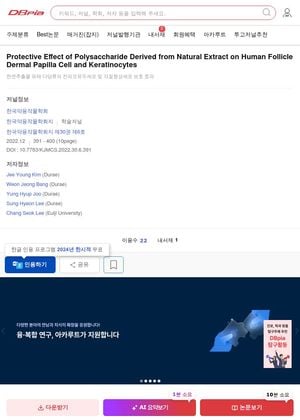TLDR Natural extracts like ginseng, green tea, shiitake, and aloe vera may help prevent hair loss by protecting hair-related cells.
This study evaluated the skin-protective effects of polysaccharide extracts from ginseng, green tea, shiitake, and aloe vera on human follicle dermal papilla cells (HFDPC) and keratinocytes (HaCaT). The extracts were assessed for total sugar content and antioxidant activity. Results showed that these polysaccharides promoted cell proliferation and suppressed hydrogen peroxide-induced apoptosis in both cell types. The findings suggest that these natural extracts could be developed as effective ingredients for preventing hair loss in the cosmetics and pharmaceutical industries.
1 citations
,
August 2022 in “Journal of Dermatological Treatment” Dutasteride is the most effective for hair loss but may cause sexual and mental side effects.
 4 citations
,
March 2021 in “Asian Journal of Beauty and Cosmetology”
4 citations
,
March 2021 in “Asian Journal of Beauty and Cosmetology” Dendropanax, sea salt, and other extracts can help reduce hair loss and promote hair growth.
 16 citations
,
October 2019 in “Biological & Pharmaceutical Bulletin”
16 citations
,
October 2019 in “Biological & Pharmaceutical Bulletin” Houttuynia cordata extract may help hair grow by improving cell survival and increasing cell growth.
 32 citations
,
July 2017 in “Clinical and Experimental Dermatology”
32 citations
,
July 2017 in “Clinical and Experimental Dermatology” Finasteride effectively treats hair loss in transgender men with few side effects.
3 citations
,
December 2015 in “Asian journal of dermatology” Natural plant extracts with sweet flag can significantly reduce hair loss and increase hair density and thickness in people with alopecia.
 21 citations
,
January 2015 in “Journal of Dermatological Science”
21 citations
,
January 2015 in “Journal of Dermatological Science” Ginsenosides in Panax ginseng boost hair growth like minoxidil.
 32 citations
,
January 2015 in “Indian Dermatology Online Journal”
32 citations
,
January 2015 in “Indian Dermatology Online Journal” Minoxidil and finasteride combo maintains hair density effectively.
6 citations
,
June 2011 in “Daehan miyong hakoeji” Shiitake mushroom, buckwheat, and cypress are effective and safe for scalp care.
 321 citations
,
December 2009 in “Journal of Dermatological Science”
321 citations
,
December 2009 in “Journal of Dermatological Science” Dermal cells are key in controlling hair growth and could potentially be used in hair loss treatments, but more research is needed to improve hair regeneration methods.
January 2003 in “Chinese Journal of Reparative and Reconstructive Surgery” Dermal papilla cells can help form hair follicles and produce hair.
 66 citations
,
August 2001 in “Experimental Dermatology”
66 citations
,
August 2001 in “Experimental Dermatology” Human hair follicle cells can grow hair when put into mouse skin if they stay in contact with mouse cells.
 57 citations
,
November 1998 in “Wound Repair and Regeneration”
57 citations
,
November 1998 in “Wound Repair and Regeneration” Hair papilla cells can create and regenerate hair bulbs under the right conditions.








